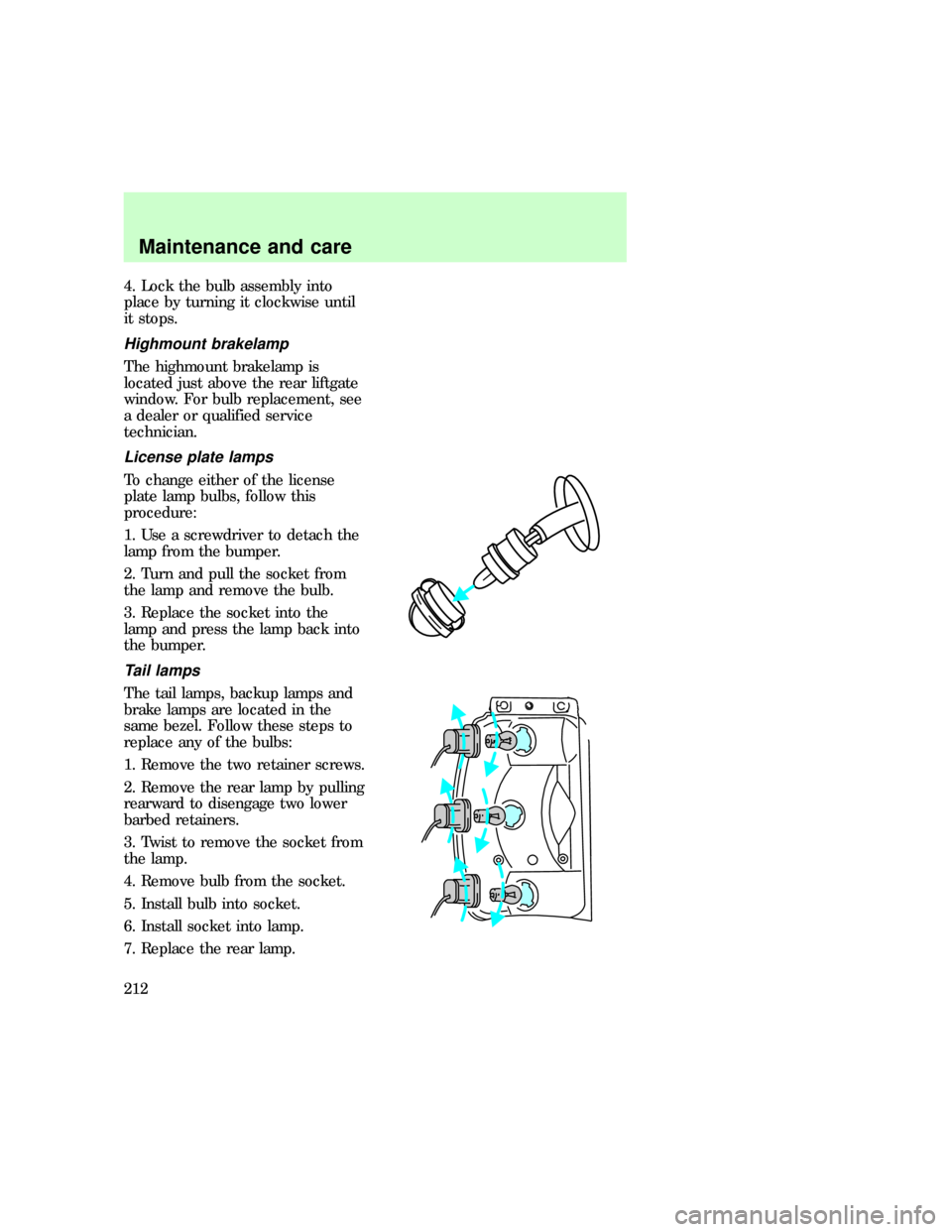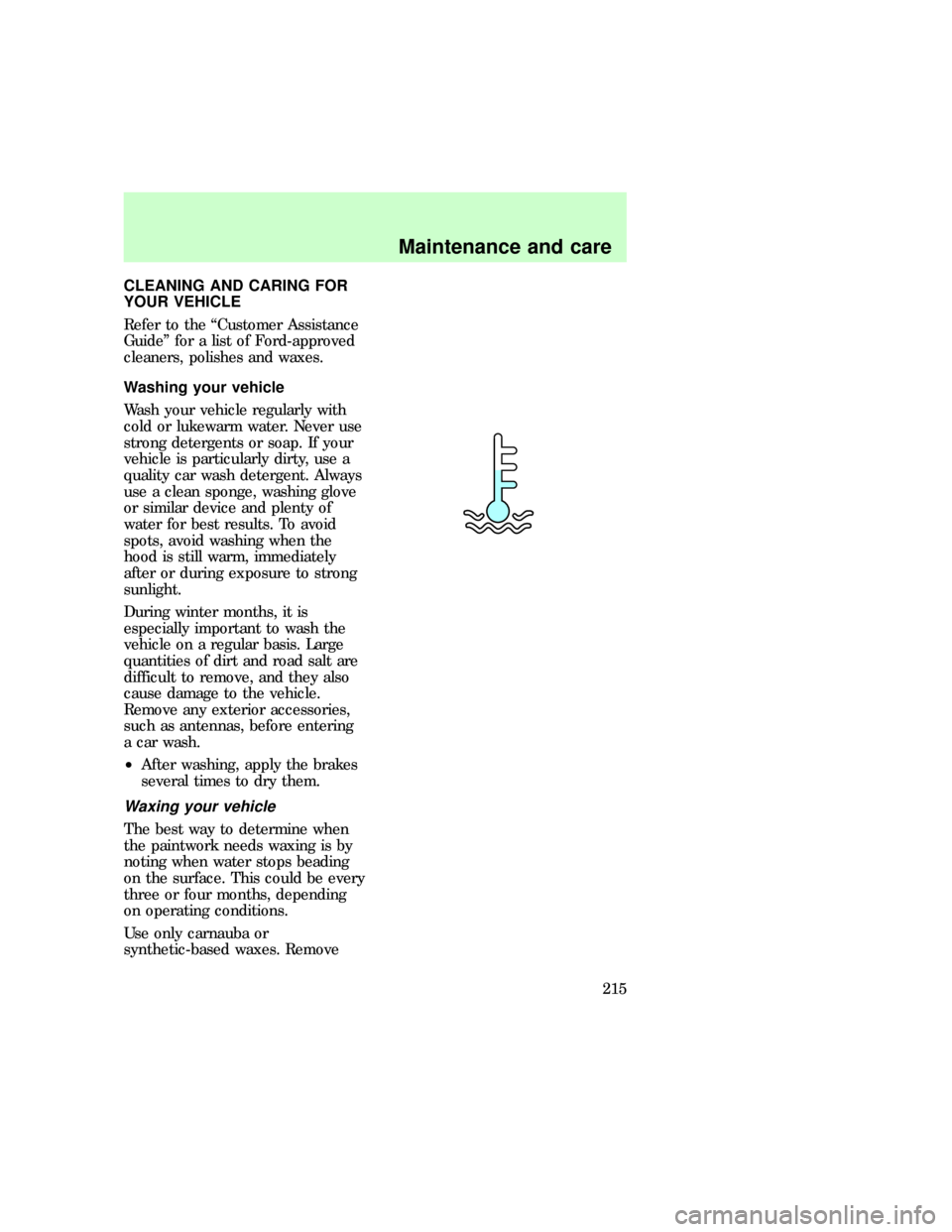Page 210 of 236
Replacing the headlamps
1. With the flat side of the bulb's
base facing upward, insert the
glass end of the bulb into the
socket. Turn the bulb left or right
to line up the grooves in the
plastic base with the tabs in the
socket. Push the bulb into the
socket until the plastic base
contacts the rear of the socket.
2. Slip the retaining ring over the
plastic base until it hits the rear of
the socket. Lock the ring by
rotating it clockwise until you feel
it stop.
3. Press the electrical connector
into the rear of the plastic base
until it snaps, locking it into
position.
4. Turn the headlamps on and
ensure they work properly.
Foglamps (if equipped)
1. Disconnect the electrical
connector from the back of the
foglamp by turning it
counterclockwise.
2. Remove the bulb by lifting the
retaining clip and pulling the bulb
from the assembly.
3. Replace the bulb and insert the
bulb assembly back into the
foglamp.
LIFT
uno_foglamps
Maintenance and care
211
Page 211 of 236

4. Lock the bulb assembly into
place by turning it clockwise until
it stops.
Highmount brakelamp
The highmount brakelamp is
located just above the rear liftgate
window. For bulb replacement, see
a dealer or qualified service
technician.
License plate lamps
To change either of the license
plate lamp bulbs, follow this
procedure:
1. Use a screwdriver to detach the
lamp from the bumper.
2. Turn and pull the socket from
the lamp and remove the bulb.
3. Replace the socket into the
lamp and press the lamp back into
the bumper.
Tail lamps
The tail lamps, backup lamps and
brake lamps are located in the
same bezel. Follow these steps to
replace any of the bulbs:
1. Remove the two retainer screws.
2. Remove the rear lamp by pulling
rearward to disengage two lower
barbed retainers.
3. Twist to remove the socket from
the lamp.
4. Remove bulb from the socket.
5. Install bulb into socket.
6. Install socket into lamp.
7. Replace the rear lamp.
uno_highmount
uno_license_plate
uno_tail_lamps
uno_interior_bulbs
Maintenance and care
212
Page 212 of 236
Replacing the interior bulbs
Check the operation of the
following interior bulbs frequently:
²interior overhead lamp
²map lamp
²courtesy and cargo lamps
Map lamps
To change the map lamp bulbs:
1. Use a small screwdriver to pry
off the lens.
2. To remove the bulbs, rotate
each bulb holder counterclockwise.
The bulb and bulb holder will drop
out.
3. Pull the bulb from the bulb
holder and replace it.
4. To replace the bulb, push it
back into the assembly and rotate
it clockwise.
5. Replace the lens by pressing it
back in.
Bulb specifications
Function Number of bulbs Trade number
Exterior bulbs
Front park/turn lamps 4 3156NAK
Headlamps 2 9007
Rear license plate
lamps2
3156
Backup lamp 2 3156K
Rear/turn/sidemarker 2 3156K
Rear/stop/tail 2 3157K
Interior illumination
LAMP LAMPMODE
uno_maplamps
uno_bulb_spec_chart
Maintenance and care
213
Page 213 of 236
Function Number of bulbs Trade number
Cargo lamp 1 211-2
Interior overhead lamp 1 912 (906)
Front door courtesy
lamp1
168
Map lamps 2 168 (T10)
Ashtray lamp 1 161
Glove compartment
lamp1
194
AIMING THE HEADLAMPS
The alignment of your headlamps
should be checked by a qualified
service technician if:
²Oncoming motorists frequently
signal you to deactivate your
high beams, and your high
beams are not activated.
²The headlamps do not seem to
provide enough light for clear
night vision.
²The headlamp beams are
pointed substantially away from
a slightly down and to the right
position.
uno_aiming_headlamps
com_cleaning_caring.01
Maintenance and care
214
Page 214 of 236

CLEANING AND CARING FOR
YOUR VEHICLE
Refer to the ªCustomer Assistance
Guideº for a list of Ford-approved
cleaners, polishes and waxes.
Washing your vehicle
Wash your vehicle regularly with
cold or lukewarm water. Never use
strong detergents or soap. If your
vehicle is particularly dirty, use a
quality car wash detergent. Always
use a clean sponge, washing glove
or similar device and plenty of
water for best results. To avoid
spots, avoid washing when the
hood is still warm, immediately
after or during exposure to strong
sunlight.
During winter months, it is
especially important to wash the
vehicle on a regular basis. Large
quantities of dirt and road salt are
difficult to remove, and they also
cause damage to the vehicle.
Remove any exterior accessories,
such as antennas, before entering
a car wash.
²After washing, apply the brakes
several times to dry them.
Waxing your vehicle
The best way to determine when
the paintwork needs waxing is by
noting when water stops beading
on the surface. This could be every
three or four months, depending
on operating conditions.
Use only carnauba or
synthetic-based waxes. Remove
com_washing_vehicle.01
com_waxing_vehicle.01
Maintenance and care
215
Page 215 of 236

any bugs and tar before waxing
vehicle. Use cleaning fluid or
alcohol with a clean cloth to
remove. Use tar remover to
remove any tar spots.
Repairing paint chips
Minor scratches or paint damage
from road debris may be repaired
with touch-up paint, paint repair
foil or aerosol paint spray from the
Ford accessory line. Observe the
application instructions on the
products.
Remove particles such as bird
droppings, tree sap, insect
remains, tar spots, road salt and
industrial fallout immediately.
Cleaning the wheels
Wash the wheels with the same
detergent you use to clean the
body of your vehicle. Do not use
acid-based wheel cleaners, steel
wool, fuel or strong detergents.
Never use abrasives that will
damage the finish of special wheel
surfaces. Use a tar remover to
remove grease and tar.
Cleaning the engine
Engines are more efficient when
they are clean because grease and
dirt buildup act as insulators and
keep the engine warmer than
normal. Follow these guidelines to
clean your engine:
²Take care when using a power
washer to clean the engine. The
com_repairing_chips
uno_wheels_cleaning
com_engine_cleaning.01
Maintenance and care
216
Page 216 of 236
high pressure fluid could
penetrate the sealed parts and
cause damage.
²Do not spray with cold water to
avoid cracking the engine block.
²Cover the highlighted areas to
prevent water damage when
cleaning the engine.
Maintenance and care
217
Page 217 of 236
²Never wash or rinse the engine
while it is running; water in the
running engine may cause
internal damage.
Cleaning plastic exterior parts
Use a vinyl cleaner for routine
cleaning of plastic. Clean with a tar
remover if necessary. Do not clean
plastic parts with thinners,
solvents or petroleum-based
cleaners.
Cleaning the exterior lamps
Wash the exterior lamps with the
same detergent you used to wash
the exterior of your vehicle. Use
glass cleaner or tar remover if
necessary.
To avoid scratching the lamps, do
not use a dry paper towel,
chemical solvents or abrasive
cleaners to clean the lamps.
Cleaning the wiper blades
If the wiper blades do not wipe
properly, clean both the windshield
and wiper blades using undiluted
com_plastic_exterior.01
uno_exterior_lamps
uno_wiper_cleaning
Maintenance and care
218